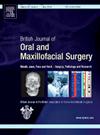Outcomes of temporomandibular joint replacement using an endaural incision and endoscopic assistance – A report of 104 cases
IF 1.9
4区 医学
Q3 DENTISTRY, ORAL SURGERY & MEDICINE
British Journal of Oral & Maxillofacial Surgery
Pub Date : 2025-06-04
DOI:10.1016/j.bjoms.2025.05.012
引用次数: 0
Abstract
Temporomandibular joint replacement is performed in patients with severe disorders of the temporomandibular joint with the aim of improving quality of life, function and pain. Traditionally, this has been carried out using a preauricular or endaural incision in addition to a submandibular incision. In this study, a novel technique was used wherein a total temporomandibular joint replacement was performed through an endaural incision with endoscopic assistance. This negated the need for a submandibular incision, with the aim of minimising the complications of open joint surgery. This is a retrospective cohort study of 104 joint replacements in 82 patients using this technique for the treatment of pathology or end-stage joint disease. The primary outcome variable was improvement in pain and quality of life measurements, whilst secondary outcome variables were facial nerve function and mouth opening. Pain intensity (/10) decreased postoperatively for worst pain score (8.4 to 4.5, p < 0.001) and average pain score (6.1 to 3.0, p < 0.001). The average Graded Chronic Pain Scale score decreased postoperatively from 67.7 to 32.7 (p < 0.001). The Jaw Function Limitation Scale had an overall reduction from 4.29 to 1.55 postoperatively (p < 0.001). There were 20 cases (19.4%) of temporary facial nerve weakness, all of which had resolved by six months. Mouth opening increased from 31.6mm preoperatively to 36.5 mm postoperatively (p < 0.01). This study shows similar or reduced rates of temporary facial nerve weakness compared to other studies whilst still significantly improving patients’ quality of life postoperatively, demonstrating that good clinical outcomes can be achieved through an endaural incision with endoscopic assistance.
经腔镜辅助下硬膜切开颞下颌关节置换术104例疗效分析
颞下颌关节置换术是对患有严重颞下颌关节疾病的患者进行的手术,目的是改善患者的生活质量、功能和疼痛。传统上,除了下颌骨切口外,还使用耳前或耳膜内切口。在这项研究中,采用了一种新的技术,在内窥镜辅助下通过硬膜切口进行全颞下颌关节置换术。这消除了下颌下切口的需要,目的是尽量减少开放关节手术的并发症。这是一项回顾性队列研究,对82例使用该技术治疗病理或终末期关节疾病的104例关节置换患者进行研究。主要结果变量是疼痛和生活质量测量的改善,而次要结果变量是面部神经功能和开口。术后疼痛强度(/10)降低,最差疼痛评分(8.4至4.5,p
本文章由计算机程序翻译,如有差异,请以英文原文为准。
求助全文
约1分钟内获得全文
求助全文
来源期刊
CiteScore
3.60
自引率
16.70%
发文量
256
审稿时长
6 months
期刊介绍:
Journal of the British Association of Oral and Maxillofacial Surgeons:
• Leading articles on all aspects of surgery in the oro-facial and head and neck region
• One of the largest circulations of any international journal in this field
• Dedicated to enhancing surgical expertise.

 求助内容:
求助内容: 应助结果提醒方式:
应助结果提醒方式:


